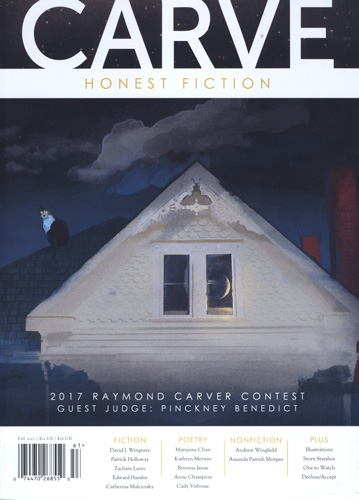Carve – Fall 2017
Reading Carve, named for Raymond Carver, is a unique experience. The cover of the Fall 2017 issue is freshly-styled and modern, and the magazine format is a nice contrast to standard lit journal dimensions. This issue features the winners and Editor’s Choices of the 2017 Raymond Carver Short Story Contest, as well as an author interview following each piece. Though the interviews might disrupt the flow of the magazine for some readers, most of them are engaging and reveal important details about writing methods and inspiration. Carver fans will likely be delighted to discover that each interview is titled “What We Talk About.”
Reading Carve, named for Raymond Carver, is a unique experience. The cover of the Fall 2017 issue is freshly-styled and modern, and the magazine format is a nice contrast to standard lit journal dimensions. This issue features the winners and Editor’s Choices of the 2017 Raymond Carver Short Story Contest, as well as an author interview following each piece. Though the interviews might disrupt the flow of the magazine for some readers, most of them are engaging and reveal important details about writing methods and inspiration. Carver fans will likely be delighted to discover that each interview is titled “What We Talk About.”
Another intriguing feature is the “story statshot,” which reveals the date of a story’s first draft, number of drafts written, number of times the piece has been rejected, and whether or not it is the author’s first publication. While this information is valuable to writers, at present the statshot does break up the opening paragraphs of each story, forcing the text to wrap around it. It could be more effectively placed at the start or finish of the piece.
Finally, the most unique element of the magazine is the Decline/Accept section, which features a story that Carve has rejected in the past, but which has since been accepted elsewhere. Here, the editors of Carve invite commentary from the rejected author, reveal their staff’s reaction to the piece, and compare the original text to the new, edited version. Reading through the issue, seeing the innovation and the interest in craft, it is clear that Carve is a magazine for writers who are readers too. This interest in the development of writers, coupled with the excellent work contained in its pages, makes Carve a worthy tribute to its namesake.
“Richard” by David J. Wingrave, which finished first in the Raymond Carver Contest, is an excellent start to the issue. It follows a boy with a new pet, caught up in a parental struggle he doesn’t quite comprehend, trying to make his mother’s world beautiful. Following the story is an author interview with Wingrave, in which he reveals his personal connections to the story, including a childhood spent in Northern Cyprus and an underused zoology degree. “Richard” came to its author in a dream, an octopus washing up on the beach, and the resulting story is an alloy of this dream and the world Wingrave grew up in. The story was written over the course of three years and saw roughly thirty drafts as its author came back intermittently to tweak a line or two. “I didn’t even stop working on it because I was happy with it,” he says in his interview. “I stopped working on it because it reached an exhausted point where I had to get it out of my life.” How lucky its readers are that Wingrave finally relented, freed his work from the infinite carousel of revision. Instead, the story survived, lovely, superbly-crafted, set free.
In her poem “In All My Dreams My Love and I Are Chased by Terrible Men,” Cady Vishniac transfers the unreliable narrator from prose to poetry, issuing amendments to previous statements much like the narrator of David Markson’s Wittgenstein’s Mistress. “By love I mean my daughter” and “My daughter holds my hand, by which I mean I carry her” are two such examples. The poem tells a story of relentless pursuit, of being born female and therefore desired by “the terrible men” who are soldiers and cops, a mob. In this poem, a trip to an Ohio Kroger is more than an errand: it is a fragmented, dizzying journey where a cornfield is a busy street, where growing up means growing strong, means being able to outrun a police cruiser. “My daughter is tired from riding my shoulder,” Vishniac writes. “By tired I mean she was born female, and therefore marked.”
Both nonfiction pieces in the issue are skillfully-written, calm reflections on the lives of their writers. In the first piece, “Back to Middle Earth” by Andrew Wingfield, the author describes his son’s bout of immune thrombocytopenia, a disorder that drastically reduces the body’s platelet count and makes physical contact, particularly head trauma, potentially lethal. While they wait for his platelet count to rise, father and son bond over Tolkien, finding solace and wonder in the pages of The Fellowship of the Ring. Eventually, Wingfield’s son regains his health and seeks out literary worlds of his own. The second nonfiction piece, “On a Field, Sable” by Amanda Parrish Morgan, a teacher and cross-country coach, explores past shame, the self-flagellation of running, and a fascination with The Scarlet Letter. Morgan cautions her readers about seeing weight-loss stories as rebirth. Her own experience was more masochistic, yet it was a source of pride, confusing and meaningful like life itself.
Pick up a copy of the Fall 2017 issue of Carve for more unique poetry and prose.
[www.carvezine.com]





